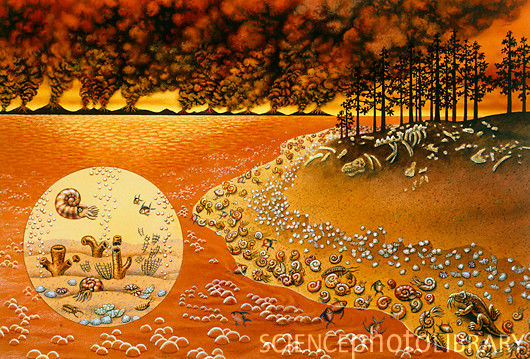The greatest mass extinction in the history of life
This was originally posted at: http://blogs.egu.eu/palaeoblog/?p=1204
In palaeontology, there are so many things more important than dinosaurs. For example, the study of large-scale patterns in the history of life on Earth, commonly known as macroevolution, is all about uncovering patterns of speciation and extinction. We are currently about to enter the sixth mass extinction within the last 542 million years of life on Earth, so figuring out exactly what happened during periods of elevated extinction and ecosystem catastrophe is pretty damn important if we want to offset as much damage as possible.
Recently, a suite of new papers have been published giving detailed insight into the environmental and biological patterns and processes throughout the Permian-Triassic mass extinction, an event 252 million years ago that saw the demise of greater than 90% of life on this planet (numbers vary depending on which measure you use). What I’d like to offer here are bitesize summaries of each, and show that there is much more important research out there in palaeontology than just ‘woo new dinosaur’.

The first of these studies regards a potential driving force for this epic life destruction episode – methanogenic bacteria! Oh how the mighty can fall.. This study was covered by Akshat Rathi of Conversation UK (whose birthday it is today!), but as far as I’m aware, that’s pretty much it, and the same for the rest of the stuff mentioned here. This complicated study attempted to show the link between the origins of a certain type of bacteria, a large disruption in Earth’s carbon cycle, and the timing of the major extinction episode. However, there appear to be many issues with spatial resolution, and the precise timings of these events which lead me to think that the conclusion of the primary driver of this extinction being detected are a little tenuous (for example, the possible 200 million year origination time range for the microbes in question). It is still more likely that what they discovered is another part of a ‘perfect storm’ of environmental perturbations, such as changing sea levels and dramatic temperature changes, that ultimately led to catastrophic reorganisation of global ecosystems.
One major argument against the use of the fossil record in any meaningful predictive sense to offset the current global biodiversity crisis is the time resolution of events that we can measure, which often gets worse the further we go back in time. However, at the Permian-Triassic extinction boundary, we now have – in places – resolution at the millennial time scale! As such, we can now track patterns of environmental disruption, biotic response, ecosystem reorganisations, and the drivers of these patterns at a much higher degree of accuracy than previously thought possible. For example, we’ve now been able to show that disruption to the carbon cycle (*cough* like modern times *cough*) occurred and persisted for about 500,000 years around the boundary before returning to stable levels.
The final two papers I wish to highlight concern what happened after the extinction, the recovery phase. Studies like this are important, as if we can’t stop this global diversity crisis, then we can at least figure out how animals and ecosystems are likely to respond in the future. The first of these concerns the ecological or functional diversity of sea-dwelling (marine) animals in response to extinction at the Permo-Triassic boundary. Some 62-74% of marine genera went extinct (a lot), but this study shows that despite this, the ecological diversity of the remaining animals was still pretty high – the extinction wasn’t particularly selective, but was more like a ‘field of bullets’, just hitting everything in it’s path, and hard. What we do see is a heterogeneous (sci-speak for different, isn’t that useful) level of functional diversity changing depending on where you live. For example, if you lived on a tropical reef, chances are you’d get hit a bit harder in terms of the total ecological diversity decimated. Recovery, however, in these regions, took many 10s of millions of years, which is quite bad news for all you reef lovers out there (and also a MASSIVE wake up call to governments to actually get their sh*t together and start protecting our environments).
The second paper is a little more niche, concerning the recovery of marine predators including fish (yawn), amphibians, and reptiles. What this study shows is that, similar to above in marine invertebrates, trophic diversity in these predators wasn’t hit as hard as you might think when looking at how hard their species-level diversity was hit. Collectively, what these two studies show is that life has the ability to bounce back, albeit after many millions of years, from extinction when high levels of ecological diversity are maintained. This is often accompanied by massive ecosystem reorganisations, and the radiation of new and often bizarre forms, but additionally tells us quite simply that we cannot afford global-scale biodiversity loss of this magnitude. Unless that biodiversity loss is focused solely on the Tory party.
I hope this selection of articles demonstrates that there’s quite a lot of awesome, and useful, palaeontological research happening out there, with the potential for real-world applications in this time of ongoing environmental and biological change. So this is a sort of call to palaeontologists and members of the media, including science bloggers (even I’m guilty of riding the dino-train at times). Stop reporting about new dinosaurs. It does no-one any favours. Palaeontologists will consistently be misconstrued as scientists who only research dinosaurs, when the reality couldn’t be further off. Coverage of other branches of palaeontology, like mass extinctions, will suffer as a result. A great example of wider writing about palaeontology is from Travis Park, a PhD student who blogs over at scilogs.
The counter-argument often offered to this is that dinosaurs are a gateway science, and offer insight into the rest of the field. In terms of the mainstream media, this is often little more than an excuse or front for an attention-grabbing new discovery. Extremely rarely are articles about new dinosaurs ever in more depth or exploratory in nature than ‘omg, look new dinosaur’.
For example, the recent naming and discovery of Anzu wyliei was a reasonably interesting find, but did little to benefit palaeontology as a science. However, by some combination of researchers, press officers, and media folk, it was given this wonderfully woeful spin of being the ‘chicken from Hell’, superficially looking like a chicken, and being from the Hell Creek Formation in the USA. Anzu didn’t need this spin. It’s etymology, or what it was named after, is an ancient Mesopotamian mythological feathered devil, which is awesome enough in itself! Anyone who actually read the paper before reporting on this would have got that, and realised that the renaming of the ‘chicken from Hell’ was completely unnecessary spin, serving only to exaggerate the importance of this new dinosaur species, which are actually being named about once ever week at the current rates. Not that mind blowing. The frustrating thing is that this finding received collectively an recieved insurmountable amount more coverage than the four papers highlighted above.

So I guess my overall point is this. We should align the importance of discoveries in palaeontology proportionally to their media coverage, instead of just covering the simple ‘sexy’ stories. Yes, dinosaurs are cool, and new findings are often quite interesting, but they mean so little for us compared to the further range of palaeontological research out there, including those articles covered above. If you do want to write about dinosaurs, do it in the broader context beyond just a new fossil find. This will take a combined effort from palaeontologists, bloggers, press officers, and the traffic hungry media, but ultimately will be beneficial to the general public sphere in terms of their insight into palaeontology, as well as the field so that we can showcase the depths of research that remain so often sadly hidden away.